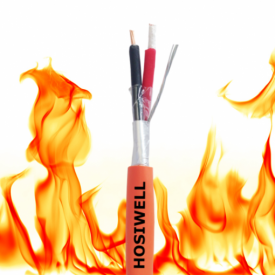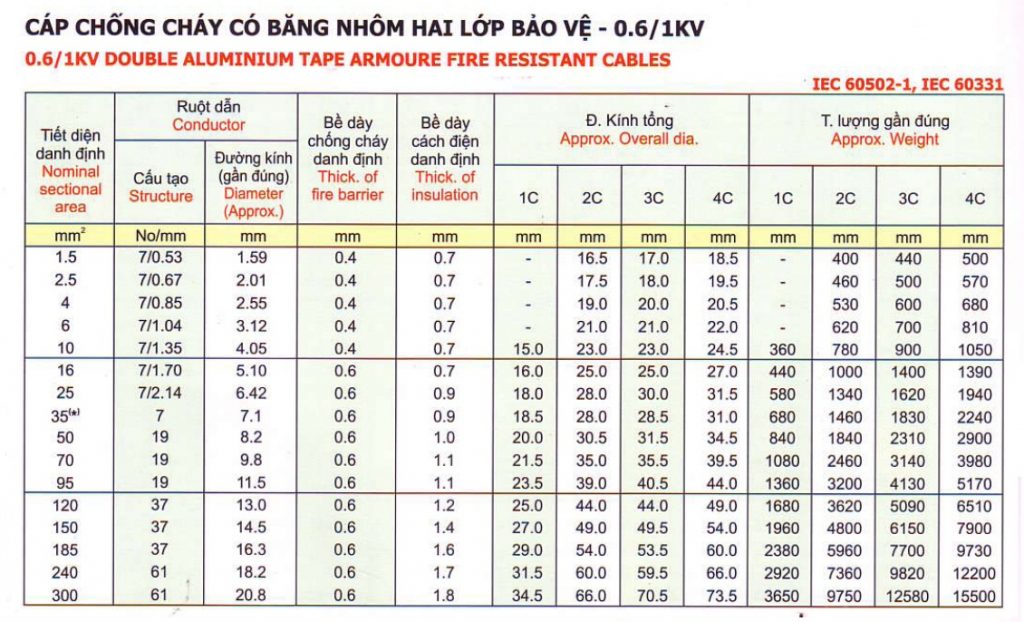CONCEPTS ON ELECTRIC CABLE - FIRE CABLE - CONTROL CABLE
Updated: 20-08-2019 | Hits: 152
Electric wires and cables are widely used products for national business branches and social consumption. Accompanying with the electricity industry, contributing to the construction of electricity projects and projects. It can be said that electric wires and cables are indispensable products in life. To better understand, let's learn about the concept of wires and cables.
I. UNDERSTANDING THE ELECTRIC CABLE
1. Concepts
- The conductor consists of one or several conductive cores, with or without insulation. We often call the wire wrap or bare wire.
- The cable consists of conductive cores (still with a single-core cable, called a single cable), with an insulating shell and additional protective covers. Often these protective covers enhance cable protection to withstand external influences such as impact force, water, and ultraviolet rays in sunlight.
2. Uses
Wires, cables used for power transmission (or control signals - control cables) or for connecting electrical equipment in industry and civil.
Sign:
- Electric wire: in construction is usually single wire, 1 insulation layer. Symbol: CV or CE
- Cable: multiple cores, 1 insulation layer for each core and 1 layer for copper. Sign CVV, CEV, CVE (C: VND, E: XLPE, V: PVC)
- Conductive conductor: Copper (copper: Cu) or aluminum (aluminum: Al)
- Insulation class: PVC or XLPE
- Fillers: PP fibers (Polypropylene)
- Wrap tape: nonwoven tape
- Inner layer: PVC or PE
- Metal armor protection: DATA, DSTA, SWA ...
- Outer cover: PCV, PE or HPPE ...

4. Classification
Classification by conductor structure:
- Civil conductor hard conductor (one hard thread or 7 strands)
- Civil conductor with flexible conductor (many strands of flexible strands together)
- Classification by number of electric conductors:
- Single wire: Cu / PVC 1x ... .mm2
- Double wire: Cu / PVC / PVC 2x ... .mm2
- Triple conductor wire: Cu / PVC / PVC 3x ... .mm2
Sort by sheath shape:
- Civil wire wrapped round
- Civil wire in oval shape
- Wire-coated civil wire (sup wire) ...
II. LEARN ABOUT FIRE FIGHTING CABLES
In the application of techniques and infrastructure, fire safety is a top concern. Because of this, fire-proof cards are used to minimize fire and explosion accidents. Learn about flame retardant cables to be able to control possible risks and prevent fires.
1. Fire-resistant cable
The cables produced by solids are smooth or copper braided. Previously, fire-resistant cable casing was made of synthetic resin (PVC). But because the fire shell will create smoke and release a large amount of toxic gas into the environment that is dangerous to life, the suppliers have changed it to make it safer. Currently, fire-resistant cables are made of materials with little smoke and do not produce toxic gases.
2. Use flame-retardant cable
Fire-resistant cable is a type of cable used in high-quality buildings and requires high safety (Airport, buildings, commercial areas, high-class residences, resorts ...). In developed countries like Singapore, fire-resistant cable is used a lot in the electrical system of the project (especially fire escape system, fire alarm system, main electrical system ..)
Used in systems:
- Fire alarm system.
- Fire sprinkler system.
- Smoke detector and detector.
- Emergency warning light system and emergency exit notification.

3. Structure and features of fire-resistant cable
The conductive core is protected by flame-retardant tape and insulated by a thermosetting compound of less halogen or XLPE smoke. The cores are put together and protected with a non-halogen smoke-free material enclosure wrapped around the cable for multi-core or aluminum conductor cables for single and end-layer shielded cables. Outside non-halogen smoke materials.
Fire-resistant cable is a type of cable composed of: Copper core, insulating layer Mica, XLPE insulation (type 1 core with cross-section less than 6mm² does not have this layer), LSZH protective shell.
The shielded cables have no inner lining and armored layer. The less halogen-free casing of all these cables is UV-resistant. Cable FR has 600 / 1000V voltage type and is manufactured according to BS 7211 (Single conductor), IEC 60502 (without armor) and BS 7846 (Armor).
- Type: 1C x 1.5mm 2 to 1C x 1000mm 2 (Single core conductor)
- Type: 1C x 10mm 2 to 1C x 1000mm 2, 2C x 1.5mm 2to 4C x 500mm 2 (With armor)
- Type: 1C x 1.5mm 2 to 1C x 1000mm 2, 2C x 1.5mm 2to 4C x 500mm 2 (No armor)
The purpose of using fire-resistant cables is to ensure safety for people, reduce the rate of fire accidents as well as damage to property owners. This is one of the indispensable devices in the construction system. Play an important role in preventing accidents about people and property.
III. HOW TO CHOOSE CABLE IN BUILDING
With so many types of electric wires on the market today, it is not easy to choose which wires and brands to trust. With some experience, please give some instructions for selecting electric cables in construction as follows:
- Do not choose strings without labels on the packaging, no manufacturer name, no clear address.
- Should not choose the wire but on the wire does not have basic information such as: brand, type of wire type, cross section, conductor structure (number of fibers and diameter per fiber), production standards.
- Good wire usually has the appearance of glossy, smooth plastic shell.
- The insulating plastic of the wire is very flexible, when it is removed from the conductor, it can be doubled and tripled to the original length without breaking. The wire may bend many times or twist the knots but the insulation surface is not cracked.
- The conductor can be checked, by counting the number of internal fibers compared to the number of fibers recorded outside. The diameter of the inner filaments is very difficult to check, because there must be a specialized ruler to measure. However, for a reputable brand, on the line with the specific conductor structure (number of fibers and diameter per strand), it can be trusted.
- Good wire has bright, shiny conductor, if it is copper wire, the conductor is very flexible. For copper conductor wires with many small fibers, it is possible to use two easily twisted conductor fingers, the small fibers do not open, do not break, do not crash into the hand. For a conductor wire with one fiber, it is possible to bend the copper tube several dozen times without breaking.
- Usually, good wires are priced higher than flat wires with the same size.
Besides, if using poor quality power cable, it can cause the following harms:
- Poor conductivity, causing pressure drop on the line makes the device ineffective, equipment life decreases rapidly.
- Overheating on the line, damaging the insulation, causing fire and explosion.
- Poor quality copper is very easy to break, difficult to connect, difficult to install in other electrical accessories.
When poor quality insulation can cause the following harms:
- Cracking insulation, open conductor, causing electric shock to people.
- Insulation crack after a short time, causing electrical leakage, power loss, fire and explosion.
- Unable to withstand the permissible temperature of the conductor, the pasty discharge causes a fire to burst.
- Do not turn off yourself when it is burned by an outside agent.
- Loss of color after a short time, confusing the wires together when repairing or replacing.
- Hopefully the above notes will help you choose the right, safe and quality power cables.
IV. LEARN ABOUT THE TYPES OF CABLES AND THE USE OF EACH TYPE
Cables are highly rated products in smart technology applications, including many types. They are used to connect control signals for specialized equipment and machinery.
This article, please excuse me today about the problem of understanding cables and their uses.
1. Single core wires & cables
- The conductors are made of annealed copper, a solid intestine or many twisted gut, PVC or PVC sheath with heat resistance, according to IEC 60227 and BS 6004 standards. These cables have a voltage of 450 / 750V.
- PVC cables with materials containing halogen acid less than 15% of the total volume when heated at 800 ºC will be used if required.
2. Low voltage wires & cables
- Low Voltage Cables without armor and PVC and XLPE armor, low voltage are manufactured according to BS standards and international IEC standards and according to customer requirements, all follow the management process. Strict quality. These wires & cables have a voltage of 600 / 1000V
- PVC power cables are manufactured with refined core copper. The cores are put together and protected by an internal PVC sheath, armored around single core cores and armored wires with aluminum conductors and finally protected by PVC on the outside. Cables without armor are those that have no extra cover and are not armored. PVC cover of all cables has the effect of preventing Ultraviolet and Burnt Fire.
- Inside and outside PVC sheath material where halogen acid escapes less than 15% of the total amount of heat when heated at a temperature of 800ºC will be provided upon request.
- The XLPE insulated power cable manufactured with copper core cable is smooth. The cores are put together and protected by an internal PVC sheath, armored around single core cores and armored wires with aluminum conductors and finally protected by an outer PVC sheath.
- Fire safety is the first criterion for infrastructure safety for modern buildings. Once a fire cannot be controlled, it can cause great damage to property as well as people. One of them, the spread of fires, halogenated gas from burning chlorine-containing materials and the inhalation of smoke makes it easy to escape a difficult and dangerous fire.
3. Signal Cable and Control cable
- There are many types of Instrumentation and Control Cables, many pairs and multiple cores with high-density copper and non-oxygen-filled cable cores and braided with PVC, PE or XLPE insulation. Other options include PVC or LSZH sheaths with or without armored conductors. Other options include all or individual screens made of aluminum / PE tape or tin-plated copper braided as screens.
- There are signal cables with voltage of 300 / 500V and are manufactured according to BS 5308 or BS EN 50288. Type of control cable with pressure voltage 600 / 1000v and manufactured according to BS 5467 or IEC 60502-1 .
- The material for external and internal PVC sheaths containing halogen acid less than 15% of the total mass when heated to 800ºC will be provided upon customer's request.
- Understanding cables can give you more information to apply to today's basic applications.











